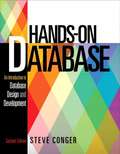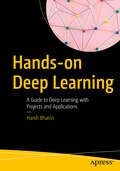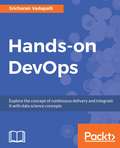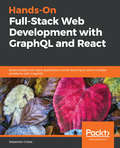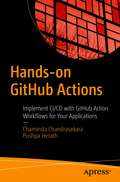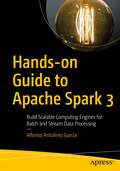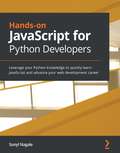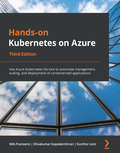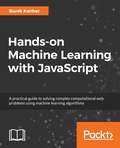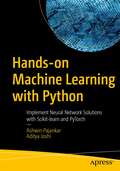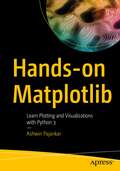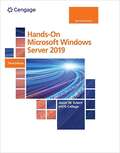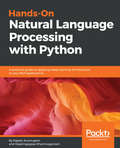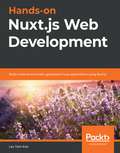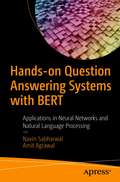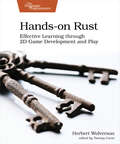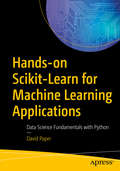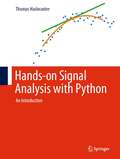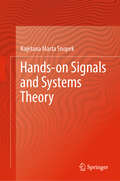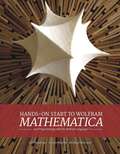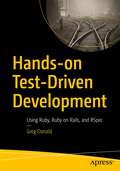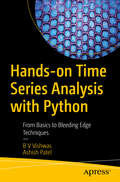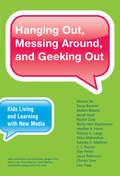- Table View
- List View
Hands-on Database: An Introduction To Database Design And Development, 2nd Edition
by Steve CongerHands-On Database uses a scenario-based approach that shows readers how to build a database by providing them with the context of a running case throughout each step of the process.
Hands-on Deep Learning: A Guide to Deep Learning with Projects and Applications
by Harsh BhasinThis book discusses deep learning, from its fundamental principles to its practical applications, with hands-on exercises and coding. It focuses on deep learning techniques and shows how to apply them across a wide range of practical scenarios. The book begins with an introduction to the core concepts of deep learning. It delves into topics such as transfer learning, multi-task learning, and end-to-end learning, providing insights into various deep learning models and their real-world applications. Next, it covers neural networks, progressing from single-layer perceptrons to multi-layer perceptrons, and solving the complexities of backpropagation and gradient descent. It explains optimizing model performance through effective techniques, addressing key considerations such as hyperparameters, bias, variance, and data division. It also covers convolutional neural networks (CNNs) through two comprehensive chapters, covering the architecture, components, and significance of kernels implementing well-known CNN models such as AlexNet and LeNet. It concludes with exploring autoencoders and generative models such as Hopfield Networks and Boltzmann Machines, applying these techniques to a diverse set of practical applications. These applications include image classification, object detection, sentiment analysis, COVID-19 detection, and ChatGPT. By the end of this book, you will have gained a thorough understanding of deep learning, from its fundamental principles to its innovative applications, enabling you to apply this knowledge to solve a wide range of real-world problems. What You Will Learn What are deep neural networks? What is transfer learning, multi-task learning, and end-to-end learning? What are hyperparameters, bias, variance, and data division? What are CNN and RNN? Who This Book Is For Machine learning engineers, data scientists, AI practitioners, software developers, and engineers interested in deep learning
Hands-on DevOps: Explore the concept of continuous delivery and integrate it with data science concepts
by Sricharan Vadapalli Prakash Sarma Jason MyerscoughKey FeaturesLearn the concepts of Bigdata and Devops and Implement themGet Acquainted with DevOps Frameworks Methodologies and Tools A practical approach to build and work efficiently with your big data clusterGet introduced to multiple flavors of tools and platforms from vendors on Hadoop, Cloud, Containers and IoT OfferingsIn-Depth Technology understanding on Data Sciences, Microservices, BigdataBook DescriptionDevOps strategies have really become an important factor for big data environments.This book initially provides an introduction to big data, DevOps, and Cloud computing along with the need for DevOps strategies in big data environments. We move on to explore the adoption of DevOps frameworks and business scenarios. We then build a big data cluster, deploy it on the cloud, and explore DevOps activities such as CI/CD and containerization. Next, we cover big data concepts such as ETL for data sources, Hadoop clusters, and their applications. Towards the end of the book, we explore ERP applications useful for migrating to DevOps frameworks and examine a few case studies for migrating big data and prediction models.By the end of this book, you will have mastered implementing DevOps tools and strategies for your big data clusters.What you will learnLearn about the DevOps culture, its frameworks, maturity, and design patternsGet acquainted with multiple niche technologies microservices, containers, kubernetes, IoT, and cloud Build big data clusters, enterprise applications and data science modelsApply DevOps concepts for continuous integration, delivery, deployment and monitoringGet introduced to Open source tools, service offerings from multiple vendorsStart digital journey to apply DevOps concepts to migrate big data, cloud, microservices, IoT, security, ERP systems
Hands-on Full-Stack Web Development with GraphQL and React: Build scalable full-stack applications while learning to solve complex problems with GraphQL
by Sebastian GrebeThe book is for web developers who want to enhance their skills and build complete full stack applications using industry standards. Familiarity with JavaScript, React, and GraphQL is expected to get the most from this book.
Hands-on GitHub Actions: Implement CI/CD with GitHub Action Workflows for Your Applications
by Chaminda Chandrasekara Pushpa HerathImplement continuous integration/continuous delivery (CI/CD) workflows for any application you develop through GitHub Actions. This book will give you an in-depth idea of implementation patterns, solutions for different technology builds, guidelines to implement your own custom components as actions, and usage of features available with GitHub Actions workflows, to set up CI/CD for your repositories. Hands-on GitHub Actions starts with an introduction to GitHub actions that gives an overview on CI/CD followed by an introduction to its workflows. Next, you will learn how to use variables in a GitHub workflow along with tokens via a REST API. Further, you will explore artifacts and caching dependencies in GitHub and use artifacts in subsequent jobs. Using self-hosted runners is discussed next where you will set up your own hardware and software to run GitHub actions. You will go through publishing packages and migrate to Azure DevOps Pipelines. Along the way, you will use Redis service and PostgreSQL service containers and create custom actions. Finally, you will work with GitHub apps and understand the syntax reference for GitHub Actions and workflows. What You Will Learn Create workflows for any platform and any language with GitHub ActionsDevelop custom GitHub actions to enhance features and usage of database and service containersUse hosted runners and create self-hosted runners for GitHub workflows Use GitHub Package registry with GitHub Actions to share and use packages Who This Book Is For DevOps teams who want to build quality CI/CD workflows.
Hands-on Guide to Apache Spark 3: Build Scalable Computing Engines for Batch and Stream Data Processing
by Alfonso Antolínez GarcíaThis book explains how to scale Apache Spark 3 to handle massive amounts of data, either via batch or streaming processing. It covers how to use Spark’s structured APIs to perform complex data transformations and analyses you can use to implement end-to-end analytics workflows. This book covers Spark 3's new features, theoretical foundations, and application architecture. The first section introduces the Apache Spark ecosystem as a unified engine for large scale data analytics, and shows you how to run and fine-tune your first application in Spark. The second section centers on batch processing suited to end-of-cycle processing, and data ingestion through files and databases. It explains Spark DataFrame API as well as structured and unstructured data with Apache Spark. The last section deals with scalable, high-throughput, fault-tolerant streaming processing workloads to process real-time data. Here you'll learn about Apache Spark Streaming’s execution model, the architecture of Spark Streaming, monitoring, reporting, and recovering Spark streaming. A full chapter is devoted to future directions for Spark Streaming. With real-world use cases, code snippets, and notebooks hosted on GitHub, this book will give you an understanding of large-scale data analysis concepts--and help you put them to use.Upon completing this book, you will have the knowledge and skills to seamlessly implement large-scale batch and streaming workloads to analyze real-time data streams with Apache Spark.What You Will LearnMaster the concepts of Spark clusters and batch data processingUnderstand data ingestion, transformation, and data storageGain insight into essential stream processing concepts and different streaming architecturesImplement streaming jobs and applications with Spark StreamingWho This Book Is ForData engineers, data analysts, machine learning engineers, Python and R programmers
Hands-on JavaScript for Python Developers: Leverage your Python knowledge to quickly learn JavaScript and advance your web development career
by Sonyl NagaleBuild robust full-stack web applications using two of the world's most popular programming languages Python and JavaScript Key Features Discover similarities and differences between JavaScript and Python coding conventions Explore frontend web concepts, UI/UX techniques, and JavaScript frameworks to enhance your web development skills Put your JS knowledge into practice by developing a full-stack web app with React and Express Book Description Knowledge of Python is a great foundation for learning other languages. This book will help you advance in your software engineering career by leveraging your Python programming skills to learn JavaScript and apply its unique features not only for frontend web development but also for streamlining work on the backend. Starting with the basics of JavaScript, you'll cover its syntax, its use in the browser, and its frameworks and libraries. From working with user interactions and ingesting data from APIs through to creating APIs with Node.js, this book will help you get up and running with JavaScript using hands-on exercises, code snippets, and detailed descriptions of JavaScript implementation and benefits. To understand the use of JavaScript in the backend, you'll explore Node.js and discover how it communicates with databases. As you advance, you'll get to grips with creating your own RESTful APIs and connecting the frontend and backend for holistic full-stack development knowledge. By the end of this Python JavaScript book, you'll have the knowledge you need to write full-fledged web applications from start to finish. You'll have also gained hands-on experience of working through several projects, which will help you advance in your career as a JavaScript developer. What you will learn Discover the differences between Python and JavaScript at both the syntactical and semantical level Become well versed in implementing JavaScript in the frontend as well as the backend Understand the separation of concerns while using Python programming for server-side development Get to grips with frontend web development tasks, including UI/UX design, form validation, animations, and much more Create modern interaction interfaces for your Python web application Explore modern web technologies and libraries for building full-stack applications Who this book is for This book is for experienced Python programmers who are looking to expand their knowledge of frontend and backend web development with JavaScript. An understanding of data types, functions, and scope is necessary to get to grips with the concepts covered in the book. Familiarity with HTML and CSS, Document Object Model (DOM), and Flask or Django will help you to learn JavaScript easily.
Hands-on Kubernetes on Azure: Use Azure Kubernetes Service to automate management, scaling, and deployment of containerized applications, 3rd Edition
by Gunther Lenz Shivakumar Gopalakrishnan Nills FranssensUnderstand the fundamentals of Kubernetes deployment on Azure with a learn-by-doing approachKey FeaturesGet to grips with the fundamentals of containers and KubernetesDeploy containerized applications using the Kubernetes platformLearn how you can scale your workloads and secure your application running in Azure Kubernetes ServiceBook DescriptionContainers and Kubernetes containers facilitate cloud deployments and application development by enabling efficient versioning with improved security and portability. With updated chapters on role-based access control, pod identity, storing secrets, and network security in AKS, this third edition begins by introducing you to containers, Kubernetes, and Azure Kubernetes Service (AKS), and guides you through deploying an AKS cluster in different ways. You will then delve into the specifics of Kubernetes by deploying a sample guestbook application on AKS and installing complex Kubernetes apps using Helm. With the help of real-world examples, you'll also get to grips with scaling your applications and clusters. As you advance, you'll learn how to overcome common challenges in AKS and secure your applications with HTTPS. You will also learn how to secure your clusters and applications in a dedicated section on security. In the final section, you'll learn about advanced integrations, which give you the ability to create Azure databases and run serverless functions on AKS as well as the ability to integrate AKS with a continuous integration and continuous delivery (CI/CD) pipeline using GitHub Actions. By the end of this Kubernetes book, you will be proficient in deploying containerized workloads on Microsoft Azure with minimal management overhead.What you will learnPlan, configure, and run containerized applications in production.Use Docker to build applications in containers and deploy them on Kubernetes.Monitor the AKS cluster and the application.Monitor your infrastructure and applications in Kubernetes using Azure Monitor.Secure your cluster and applications using Azure-native security tools.Connect an app to the Azure database.Store your container images securely with Azure Container Registry.Install complex Kubernetes applications using Helm.Integrate Kubernetes with multiple Azure PaaS services, such as databases, Azure Security Center, and Functions.Use GitHub Actions to perform continuous integration and continuous delivery to your cluster.Who this book is forIf you are an aspiring DevOps professional, system administrator, developer, or site reliability engineer interested in learning how to get the most out of containers and Kubernetes, then this book is for you.
Hands-on Machine Learning with JavaScript: Solve complex computational web problems using machine learning
by Burak KanberA definitive guide to creating an intelligent web application with the best of machine learning and JavaScriptKey FeaturesSolve complex computational problems in browser with JavaScriptTeach your browser how to learn from rules using the power of machine learningUnderstand discoveries on web interface and API in machine learningBook DescriptionIn over 20 years of existence, JavaScript has been pushing beyond the boundaries of web evolution with proven existence on servers, embedded devices, Smart TVs, IoT, Smart Cars, and more. Today, with the added advantage of machine learning research and support for JS libraries, JavaScript makes your browsers smarter than ever with the ability to learn patterns and reproduce them to become a part of innovative products and applications.Hands-on Machine Learning with JavaScript presents various avenues of machine learning in a practical and objective way, and helps implement them using the JavaScript language. Predicting behaviors, analyzing feelings, grouping data, and building neural models are some of the skills you will build from this book. You will learn how to train your machine learning models and work with different kinds of data. During this journey, you will come across use cases such as face detection, spam filtering, recommendation systems, character recognition, and more. Moreover, you will learn how to work with deep neural networks and guide your applications to gain insights from data.By the end of this book, you'll have gained hands-on knowledge on evaluating and implementing the right model, along with choosing from different JS libraries, such as NaturalNode, brain, harthur, classifier, and many more to design smarter applications.What you will learnGet an overview of state-of-the-art machine learningUnderstand the pre-processing of data handling, cleaning, and preparationLearn Mining and Pattern Extraction with JavaScriptBuild your own model for classification, clustering, and predictionIdentify the most appropriate model for each type of problemApply machine learning techniques to real-world applicationsLearn how JavaScript can be a powerful language for machine learningWho this book is forThis book is for you if you are a JavaScript developer who wants to implement machine learning to make applications smarter, gain insightful information from the data, and enter the field of machine learning without switching to another language. Working knowledge of JavaScript language is expected to get the most out of the book.
Hands-on Machine Learning with Python: Implement Neural Network Solutions with Scikit-learn and PyTorch
by Ashwin Pajankar Aditya JoshiHere is the perfect comprehensive guide for readers with basic to intermediate level knowledge of machine learning and deep learning. It introduces tools such as NumPy for numerical processing, Pandas for panel data analysis, Matplotlib for visualization, Scikit-learn for machine learning, and Pytorch for deep learning with Python. It also serves as a long-term reference manual for the practitioners who will find solutions to commonly occurring scenarios.The book is divided into three sections. The first section introduces you to number crunching and data analysis tools using Python with in-depth explanation on environment configuration, data loading, numerical processing, data analysis, and visualizations. The second section covers machine learning basics and Scikit-learn library. It also explains supervised learning, unsupervised learning, implementation, and classification of regression algorithms, and ensemble learning methods in an easy manner with theoretical and practical lessons. The third section explains complex neural network architectures with details on internal working and implementation of convolutional neural networks. The final chapter contains a detailed end-to-end solution with neural networks in Pytorch.After completing Hands-on Machine Learning with Python, you will be able to implement machine learning and neural network solutions and extend them to your advantage. What You'll LearnReview data structures in NumPy and Pandas Demonstrate machine learning techniques and algorithmUnderstand supervised learning and unsupervised learning Examine convolutional neural networks and Recurrent neural networksGet acquainted with scikit-learn and PyTorchPredict sequences in recurrent neural networks and long short term memory Who This Book Is ForData scientists, machine learning engineers, and software professionals with basic skills in Python programming.
Hands-on Matplotlib: Learn Plotting and Visualizations with Python 3
by Ashwin PajankarLearn the core aspects of NumPy, Matplotlib, and Pandas, and use them to write programs with Python 3. This book focuses heavily on various data visualization techniques and will help you acquire expert-level knowledge of working with Matplotlib, a MATLAB-style plotting library for Python programming language that provides an object-oriented API for embedding plots into applications. You'll begin with an introduction to Python 3 and the scientific Python ecosystem. Next, you'll explore NumPy and ndarray data structures, creation routines, and data visualization. You'll examine useful concepts related to style sheets, legends, and layouts, followed by line, bar, and scatter plots. Chapters then cover recipes of histograms, contours, streamplots, and heatmaps, and how to visualize images and audio with pie and polar charts. Moving forward, you'll learn how to visualize with pcolor, pcolormesh, and colorbar, and how to visualize in 3D in Matplotlib, create simple animations, and embed Matplotlib with different frameworks. The concluding chapters cover how to visualize data with Pandas and Matplotlib, Seaborn, and how to work with the real-life data and visualize it. After reading Hands-on Matplotlib you'll be proficient with Matplotlib and able to comfortably work with ndarrays in NumPy and data frames in Pandas. What You'll LearnUnderstand Data Visualization and Python using MatplotlibReview the fundamental data structures in NumPy and Pandas Work with 3D plotting, visualizations, and animationsVisualize images and audio dataWho This Book Is ForData scientists, machine learning engineers and software professionals with basic programming skills.
Hands-on Microsoft Windows Server 2019
by Jason EckertEckert's HANDS-ON MICROSOFT WINDOWS SERVER 2019 equips you with a solid foundation in basic server administration -- no prior experience required. It empowers you with the knowledge to manage servers on small to large networks and maximize Windows Server 2019 administration. <p><p>Using a logical topic flow and step-by-step exercises, it delivers thorough coverage of core Windows Server 2019 features. You will learn how to deploy Windows Server 2019 in a variety of different environments -- including those that rely on virtualization and containers -- and how to configure and manage server storage, troubleshoot performance issues and work with common Windows Server technologies and network services, such as Active Directory, DNS, DHCP, IPAM, file sharing, printing and remote access. Numerous hands-on projects and MindTap activities enable you to put what you learn into real-world practice.
Hands-on Natural Language Processing with Python: A practical guide to applying deep learning architectures to your NLP applications
by Rajalingappaa Shanmugmani Karthik Muthusamy Rajesh ArumugamIf you are a developer and want to build a deep learning application that leverages Natural Language Processing (NLP) techniques. All you need is the basics of machine learning and Python to decode the entire book.
Hands-on Nuxt.js Web Development: Build universal and static-generated Vue.js applications using Nuxt.js
by Lau Tiam KokLearn Nuxt.js for building server-side rendered, static-generated, and production-ready Vue.js web applications with the help of practical examples Key Features Explore techniques for authentication, testing, and deployment to build your first complete Nuxt.js web app Write cleaner, maintainable, and scalable isomorphic JavaScript web applications Transform your Vue.js application into universal and static-generated web apps Book Description Nuxt.js is a progressive web framework built on top of Vue.js for server-side rendering (SSR). With Nuxt.js and Vue.js, building universal and static-generated applications from scratch is now easier than ever before. This book starts with an introduction to Nuxt.js and its constituents as a universal SSR framework. You'll learn the fundamentals of Nuxt.js and find out how you can integrate it with the latest version of Vue.js. You'll then explore the Nuxt.js directory structure and set up your first Nuxt.js project using pages, views, routing, and Vue components. With the help of practical examples, you'll learn how to connect your Nuxt.js application with the backend API by exploring your Nuxt.js application's configuration, plugins, modules, middleware, and the Vuex store. The book shows you how you can turn your Nuxt.js application into a universal or static-generated application by working with REST and GraphQL APIs over HTTP requests. Finally, you'll get to grips with security techniques using authorization, package your Nuxt.js application for testing, and deploy it to production. By the end of this web development book, you'll have developed a solid understanding of using Nuxt.js for your projects and be able to build secure, end-to-end tested, and scalable web applications with SSR, data handling, and SEO capabilities. What you will learn Integrate Nuxt.js with the latest version of Vue.js Extend your Vue.js applications using Nuxt.js pages, components, routing, middleware, plugins, and modules Create a basic real-time web application using Nuxt.js, Node.js, Koa.js and RethinkDB Develop universal and static-generated web applications with Nuxt.js, headless CMS and GraphQL Build Node.js and PHP APIs from scratch with Koa.js, PSRs, GraphQL, MongoDB and MySQL Secure your Nuxt.js applications with the JWT authentication Discover best practices for testing and deploying your Nuxt.js applications Who this book is for The book is for any JavaScript or full-stack developer who wants to build server-side rendered Vue.js apps. A basic understanding of the Vue.js framework will assist with understanding key concepts covered in the book.
Hands-on Question Answering Systems with BERT: Applications in Neural Networks and Natural Language Processing
by Navin Sabharwal Amit AgrawalGet hands-on knowledge of how BERT (Bidirectional Encoder Representations from Transformers) can be used to develop question answering (QA) systems by using natural language processing (NLP) and deep learning. The book begins with an overview of the technology landscape behind BERT. It takes you through the basics of NLP, including natural language understanding with tokenization, stemming, and lemmatization, and bag of words. Next, you’ll look at neural networks for NLP starting with its variants such as recurrent neural networks, encoders and decoders, bi-directional encoders and decoders, and transformer models. Along the way, you’ll cover word embedding and their types along with the basics of BERT. After this solid foundation, you’ll be ready to take a deep dive into BERT algorithms such as masked language models and next sentence prediction. You’ll see different BERT variations followed by a hands-on example of a question answering system. Hands-on Question Answering Systems with BERT is a good starting point for developers and data scientists who want to develop and design NLP systems using BERT. It provides step-by-step guidance for using BERT. What You Will Learn Examine the fundamentals of word embeddings Apply neural networks and BERT for various NLP tasks Develop a question-answering system from scratch Train question-answering systems for your own data Who This Book Is For AI and machine learning developers and natural language processing developers.
Hands-on Rust
by Herbert WolversonRust is an exciting new programming language combining the power of C with memory safety, fearless concurrency, and productivity boosters - and what better way to learn than by making games. Each chapter in this book presents hands-on, practical projects ranging from "Hello, World" to building a full dungeon crawler game. With this book, you'll learn game development skills applicable to other engines, including Unity and Unreal. Rust is an exciting programming language combining the power of C with memory safety, fearless concurrency, and productivity boosters. With Rust, you have a shiny new playground where your game ideas can flourish. Each chapter in this book presents hands-on, practical projects that take you on a journey from "Hello, World" to building a full dungeon crawler game. Start by setting up Rust and getting comfortable with your development environment. Learn the language basics with practical examples as you make your own version of Flappy Bird. Discover what it takes to randomly generate dungeons and populate them with monsters as you build a complete dungeon crawl game. Run game systems concurrently for high-performance and fast game-play, while retaining the ability to debug your program. Unleash your creativity with magical items, tougher monsters, and intricate dungeon design. Add layered graphics and polish your game with style. What You Need: A computer running Windows 10, Linux, or Mac OS X.A text editor, such as Visual Studio Code.A video card and drivers capable of running OpenGL 3.2.
Hands-on Scikit-Learn for Machine Learning Applications: Data Science Fundamentals with Python
by David PaperAspiring data science professionals can learn the Scikit-Learn library along with the fundamentals of machine learning with this book. The book combines the Anaconda Python distribution with the popular Scikit-Learn library to demonstrate a wide range of supervised and unsupervised machine learning algorithms. Care is taken to walk you through the principles of machine learning through clear examples written in Python that you can try out and experiment with at home on your own machine.All applied math and programming skills required to master the content are covered in this book. In-depth knowledge of object-oriented programming is not required as working and complete examples are provided and explained. Coding examples are in-depth and complex when necessary. They are also concise, accurate, and complete, and complement the machine learning concepts introduced. Working the examples helps to build the skills necessary to understand and apply complex machine learning algorithms.Hands-on Scikit-Learn for Machine Learning Applications is an excellent starting point for those pursuing a career in machine learning. Students of this book will learn the fundamentals that are a prerequisite to competency. Readers will be exposed to the Anaconda distribution of Python that is designed specifically for data science professionals, and will build skills in the popular Scikit-Learn library that underlies many machine learning applications in the world of Python.What You'll LearnWork with simple and complex datasets common to Scikit-LearnManipulate data into vectors and matrices for algorithmic processingBecome familiar with the Anaconda distribution used in data scienceApply machine learning with Classifiers, Regressors, and Dimensionality ReductionTune algorithms and find the best algorithms for each datasetLoad data from and save to CSV, JSON, Numpy, and Pandas formatsWho This Book Is ForThe aspiring data scientist yearning to break into machine learning through mastering the underlying fundamentals that are sometimes skipped over in the rush to be productive. Some knowledge of object-oriented programming and very basic applied linear algebra will make learning easier, although anyone can benefit from this book.
Hands-on Signal Analysis with Python: An Introduction
by Thomas HaslwanterThis book provides the tools for analyzing data in Python: different types of filters are introduced and explained, such as FIR-, IIR- and morphological filters, as well as their application to one- and two-dimensional data. The required mathematics are kept to a minimum, and numerous examples and working Python programs are included for a quick start. The goal of the book is to enable also novice users to choose appropriate methods and to complete real-world tasks such as differentiation, integration, and smoothing of time series, or simple edge detection in images. An introductory section provides help and tips for getting Python installed and configured on your computer. More advanced chapters provide a practical introduction to the Fourier transform and its applications such as sound processing, as well as to the solution of equations of motion with the Laplace transform. A brief excursion into machine learning shows the powerful tools that are available with Python. This book also provides tips for an efficient programming work flow: from the use of a debugger for finding mistakes, code-versioning with git to avoid the loss of working programs, to the construction of graphical user interfaces (GUIs) for the visualization of data. Working, well-documented Python solutions are included for all exercises, and IPython/Jupyter notebooks provide additional help to get people started and outlooks for the interested reader.
Hands-on Signals and Systems Theory
by Kajetana Marta SnopekThis textbook presents the theory of continuous-time and discrete-time signals and systems and shows how it can be used to solve analytically different problems. The book is dedicated to engineering students who are interested in mathematical methods used to solve real technical problems connected with signals and systems. The book covers, both in continuous- and in discrete domains, analysis of signals in time domain; orthogonal signal representation including Fourier series; convolution and correlation of signals; analysis of signals in the frequency domain and signal sampling, including aliasing and stroboscopic effects, among others. The author also emphasizes the role of Fourier-, one-sided Laplace- and one-sided Z transformations in signals and systems. Chosen methods of analog and digital filter design and stability criteria of analog and digital filters are also described. The author presents the necessary theory in the form of a concise “lecture” accompanied with a number of solved original problems. Every chapter ends with examples of complete solutions with explanation and necessary graphical visualization (graphs, schemes etc.).
Hands-on Start to Wolfram Mathematica and Programming with the Wolfram Language
by Michael Morrison Cliff Hastings Kelvin MischoFor more than 25 years, Mathematica has been the principal computation environment for millions of innovators, educators, students, and others around the world. This book is an introduction to Mathematica. The goal is to provide a hands-on experience introducing the breadth of Mathematica, with a focus on ease of use. Readers get detailed instruction with examples for interactive learning and end-of-chapter exercises. Each chapter also contains authors tips from their combined 50+ years of Mathematica use.
Hands-on Test-Driven Development: Using Ruby, Ruby on Rails, and RSpec
by Greg DonaldLearn to properly test Ruby and Ruby on Rails applications by first writing failing tests, and then by implementing application code to make the failing tests pass. This book will teach you how to employ test-driven development (TDD) using RSpec while building a blog from start to finish. By the end of the book, you will be ready to deploy their fully tested blog to their own production web server using the latest versions of Ruby 3 and Ruby on Rails 7. The biggest challenge with learning and becoming comfortable with test-driven development is that software engineers often cannot imagine what writing a failing test looks like in practice. They write their implementation code first, and only then think about writing tests around their implementation code. This leads to tests that pass by accident, or tests that do not actually test anything. This book will give you the confidence to write tests in the RSpec domain-specific language. You will see your tests fail "properly" before proceeding with writing any implementation code to get them to pass. This book covers the latest techniques for writing RSpec tests, including "system" specs, and the often overlooked "view" specs, and how to integrate RSpec with other tools like Capybara, headless Chrome, and the new web driver gem. It also covers FactoryBot for mock test data and offers experienced advice on how to avoid creating tests that fail randomly. What You Will Learn Build a blog application from start to finish using test driven developmentInstall and explore popular tools used in professional Ruby software engineeringEvaluate the benefits of effective testing in RSpecExplore Capistrano for advanced user interface testing Who Is This Book For Beginner to intermediate Ruby software engineers who are interested in learning to use TDD with RSpec to test and build web applications using Ruby on Rails. Readers should have some basic experience with Ruby and Ruby on Rails and have read the "Getting Started with Rails" guide, or something similar.
Hands-on Time Series Analysis with Python: From Basics to Bleeding Edge Techniques
by B V Vishwas ASHISH PATELLearn the concepts of time series from traditional to bleeding-edge techniques. This book uses comprehensive examples to clearly illustrate statistical approaches and methods of analyzing time series data and its utilization in the real world. All the code is available in Jupyter notebooks.You'll begin by reviewing time series fundamentals, the structure of time series data, pre-processing, and how to craft the features through data wrangling. Next, you'll look at traditional time series techniques like ARMA, SARIMAX, VAR, and VARMA using trending framework like StatsModels and pmdarima. The book also explains building classification models using sktime, and covers advanced deep learning-based techniques like ANN, CNN, RNN, LSTM, GRU and Autoencoder to solve time series problem using Tensorflow. It concludes by explaining the popular framework fbprophet for modeling time series analysis. After reading Hands -On Time Series Analysis with Python, you'll be able to apply these new techniques in industries, such as oil and gas, robotics, manufacturing, government, banking, retail, healthcare, and more. What You'll Learn:· Explains basics to advanced concepts of time series · How to design, develop, train, and validate time-series methodologies · What are smoothing, ARMA, ARIMA, SARIMA,SRIMAX, VAR, VARMA techniques in time series and how to optimally tune parameters to yield best results · Learn how to leverage bleeding-edge techniques such as ANN, CNN, RNN, LSTM, GRU, Autoencoder to solve both Univariate and multivariate problems by using two types of data preparation methods for time series. · Univariate and multivariate problem solving using fbprophet. Who This Book Is ForData scientists, data analysts, financial analysts, and stock market researchers
Hanging Out, Messing Around, and Geeking Out: Kids Living and Learning with New Media (The John D. and Catherine T. MacArthur Foundation Series on Digital Media and Learning)
by Danah Boyd Mizuko Ito Sonja Baumer Matteo Bittanti Rachel CodyAn examination of young people's everyday new media practices—including video-game playing, text-messaging, digital media production, and social media use.Conventional wisdom about young people's use of digital technology often equates generational identity with technology identity: today's teens seem constantly plugged in to video games, social networking sites, and text messaging. Yet there is little actual research that investigates the intricate dynamics of youths' social and recreational use of digital media. Hanging Out, Messing Around, and Geeking Out fills this gap, reporting on an ambitious three-year ethnographic investigation into how young people are living and learning with new media in varied settings—at home, in after-school programs, and in online spaces.Integrating twenty-three case studies—which include Harry Potter podcasting, video-game playing, music sharing, and online romantic breakups—in a unique collaborative authorship style, Hanging Out, Messing Around, and Geeking Out is distinctive for its combination of in-depth description of specific group dynamics with conceptual analysis.
Happy Mum, Happy Baby: My adventures into motherhood
by Giovanna FletcherCONTAINS A BRAND NEW CHAPTERSunday Times Number One Bestseller Happy Mum Happy Baby is now a Number One podcast. A positive and uplifting book about what it is to be a mother and all things mum and baby by Celebrity Mum of the Year and phenomenally popular vlogger, author, TV presenter and actress Giovanna Fletcher.Being a mum is an incredible journey, a remarkable experience that changes how we look, how we feel, who we are. As mothers we are strong, protective, proud. We feel a love like no other.But being a parent can be hard too. It challenges us physically, mentally, emotionally. There are the days where just managing to fit a shower in amidst the endless feeding, entertaining young children and surviving on a lack of sleep feels like an achievement. With so many people ready to offer 'advice' on the best way to parent, it can feel like you are getting it all wrong.Since Giovanna and her husband Tom Fletcher have had their sons Buzz and Buddy, they have been sharing glimpses of their family life. With an infectiously positive outlook and happy take on all things mum-related, Giovanna has developed a following of fellow parents and mums-to-be.This is not a book about how to have the perfect family experience - Gi would be the first to admit she is winging it just as much as the rest of us - instead it is an honest, upbeat and incredibly personal account of her own experience of having a family. In Happy Mum, Happy Baby Giovanna shares her own journey through parenthood and in doing so, she looks at what it is to be a mother today, encourages you to be confident in yourself as a parent and celebrates how putting a focus on being a happy and confident mum can really make for a happy baby.
Happy Mum, Happy Baby: My adventures into motherhood
by Giovanna FletcherBeing a mum is an incredible journey, a remarkable experience that changes how we look, how we feel, who we are. As mothers we are strong, protective, proud. We feel a love like no other.But being a parent can be hard too. It challenges us physically, mentally, emotionally. There are the days where just managing to fit a shower in amidst the endless feeding, entertaining young children and surviving on a lack of sleep feels like an achievement. With so many people ready to offer 'advice' on the best way to parent, it can feel like you are getting it all wrong.Since Giovanna and her husband Tom Fletcher have had their sons Buzz and Buddy, they have been sharing glimpses of their family life. With an infectiously positive outlook and happy take on all things mum-related, Giovanna has developed a following of fellow parents and mums-to-be.This is not a book about how to have the perfect family experience - Gi would be the first to admit she is winging it just as much as the rest of us - instead it is an honest, upbeat and incredibly personal account of her own experience of having a family. In Happy Mum, Happy Baby Giovanna shares her own journey through parenthood and in doing so, she looks at what it is to be a mother today, encourages you to be confident in yourself as a parent and celebrates how putting a focus on being a happy and confident mum can really make for a happy baby.(P)2017 Hodder & Stoughton
